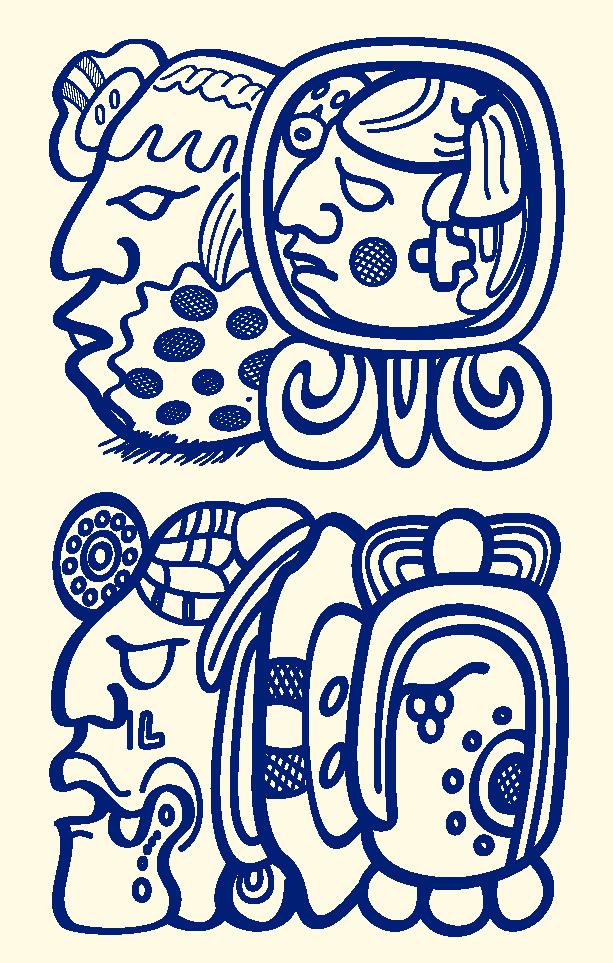
9 Ajaw 13 Yax: Drawing by Jorge Pérez de Lara
9 Ajaw 13 Yax (October 10, 2022)
Celebrating Indigenous Peoples’ Day: The Children of Sinanché and Chichimilá, Yucatán learn the Úuchben Maaya Ts’íib.
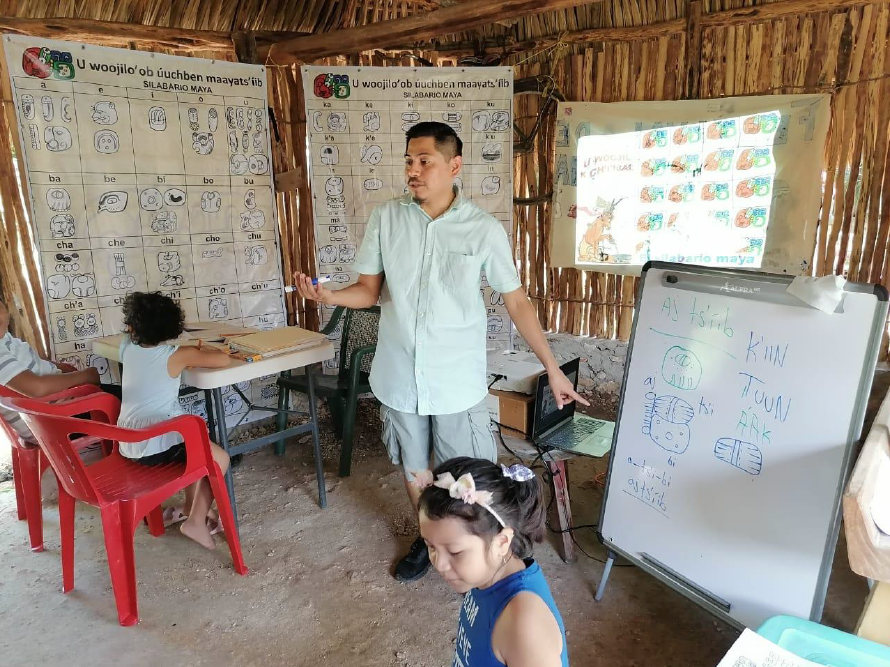 Gregorio Hau explains that an Ajts’íib is a scribe, a painter, or an artist in Chichimilá
Gregorio Hau explains that an Ajts’íib is a scribe, a painter, or an artist in Chichimilá
Today we celebrate Indigenous Peoples’ Day in the United States as a federally recognized holiday for the second year in a row. This day commemorates the achievements, the struggles, and the recognition of Indigenous Peoples in the Americas, and it provides an important counterpoint to the commemoration of Columbus Day by acknowledging that the Americas could not have been “discovered” 520 years ago when there were already millions of people living here, with hundreds of different cultures and languages.
This month, we hear from Gregorio Hau Caamal about the two workshops he taught this past July and August in Sinanché and Chichimilá, Yucatán for Yucatec Maya students who learned about the Uúchben Maaya Ts’íib, the Ancient Maya writing of their ancestors. Gregorio has partnered with MAM to teach multiple workshops in the past, and his students are clearly inspired by his enthusiasm and passion. His effective and engaging teaching style has enabled many students to learn to read and write in the Maya script.
This month we would also like to announce that we have partnered with Amazon Smile to allow those of you who purchase products through Amazon to include a donation to MAM of 0.5% of all each of your eligible purchases. It is quite easy to use!
- Simply log on to: smile.amazon.com.
- If you need to change the language, click on the down arrow to the right of the US flag icon and choose a language.
- Click on “Get Started”
- In the search tab under “Start by picking your charity,” you can type in any of the following: “Mayas for Ancient Mayan”, “Maya Antiguo Para Los Mayas”, or “Friends of the Maya” and click “Enter”.
- You will see the first choice as “Friends of the Maya Inc”, since we do business under this original name, and you will see the name “Mayas for Ancient Mayan/Maya Antiguo Para Los Mayas (MAM)” in the description. Click “Select” next to “Friends of the Maya Inc”.
- Check the box that says “Yes, I understand that I must always start at smile.amazon.com to support Friends of the Maya Inc.”
- Click “Start Shopping.”
- In order for these donations to work in the future when you shop online, you will need to first log in to smile.amazon.com rather than the standard Amazon website, so be sure to bookmark the Amazon Smile page.
Thank you very much for all of your kind support! We are grateful to all of you who have already donated using the Amazon Smile program.
We look forward to bringing you additional reports from our recently awarded mini-grants!
Yum bo’otik,
Michael Grofe, President
MAM

Kitchen space of the Tu Lu’umil Kool Tak Ta K’óoben school.
Report on the Uúchben Ts’íib Workshop in Ancient Maya Writing
taught by Gregorio Hau Caamal
2 Jix 7 Mol
August 25, 2022
On July 22 and 23, thanks to the MAM mini-grant, a workshop on Úuchben ts’íib was given to Mayan children and young people between 9 and 15 years of age in the municipality of Sinanché, Yucatán. Later, another workshop was held on the 17 August in the municipality of Chichimilá, Yucatán, Mexico in the space of the school kitchen of Tu Lu’umil Kool Tak Ta K’óoben.
The objective of this workshop is for children and young people to know and write with the ancient Mayan writing currently known as “Mayan hieroglyphs.” To achieve this objective, the following activities were carried out, fulfilling their respective specific objectives:
1. Identify syllables with the Mayan syllabary.
Materials: Canvas with printed syllabary and copies.
The assistants identified the syllables on the canvases and on their printed material and wrote the name of the corresponding syllable on their material.
2. Know the rules and order of reading and writing
In the printed material they identified the reading order of a block of glyphs and the number of syllables it can contain.
3. Write the name of plants or trees in the region
On white sheets with pencils and markers, they wrote the names of plants and/or trees endemic to the region.
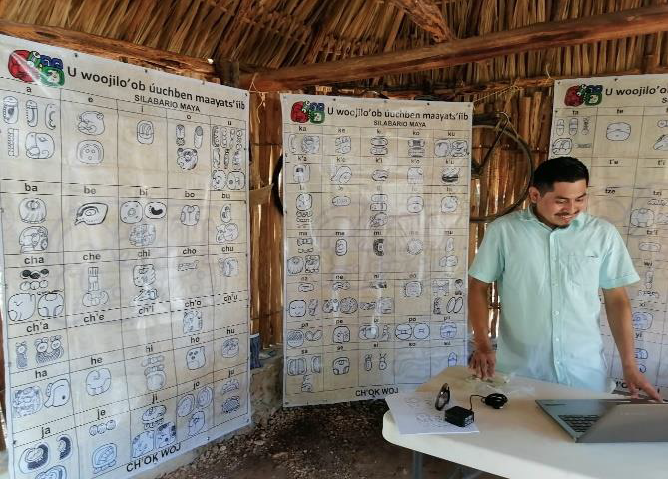
Canvases with the Maya Syllabary in Chichimilá
In this way we contribute to strengthening the knowledge that our grandfathers and grandmothers have passed down to us in the oral tradition. In the ancient Mayan writing there is proof of everything that our parents and our grandfathers and grandmothers tell as myths or legends. The secondary objective was to reinforce and promote the Mayan language and the Úucben ts’íib in the community of young people of the town, since knowledge of ancient Mayan writing is a valuable tool to achieve this goal.
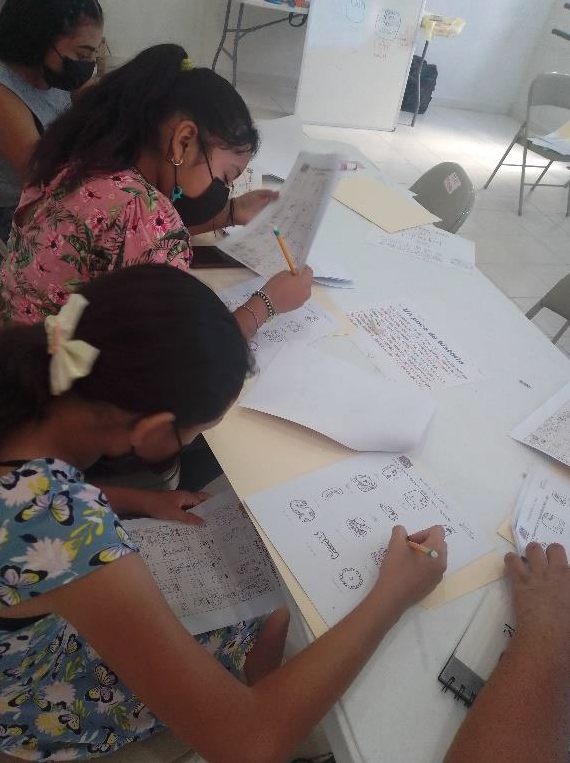
Participants in the glyph workshop in Sinanché
The first workshop was in Sinanché, which initially would take place in the space that the Suumil Mokt’aan collective has in the town; however, the conditions for that date were not conducive to holding it in this place, so it was decided to do the activity in the acoustic shell of the municipality itself that was provided by the Directorate of Culture of the Municipality of Sinanché.
Days prior to the workshop, the town’s patron saint festival was held and the community was busy with various activities, such as first communions and other events typical of these celebrations. In addition to those days, some families were affected by Covid, so it was decided to reschedule to a new workshop in the municipality of Chichimilá to compensate for the low participation of children and young people in the Ancient Maya Writing workshop.

Students writing and actively participating
There were a total of 25 participants between the two workshops, consisting of children and adolescents. The first workshop was held in two days on July 22 and 23 from 9:00 am to 1:00 pm in Sinanché. The second workshop took place in Chichimilá during one day on August 17 from 9:00 am to 1:00 pm. It is important to mention that the participants of the workshop in Chichimilá have already participated in a previous workshop with José Alfredo Hau Caamal, so they did not have many difficulties to carry out the activities proposed during the session.
The resource material was taken from various sources, such as Harri Kettunen and Christophe Helmke’s, Introduction to Mayan Hieroglyphs (Wayeb,17th ed, 2020), Fray Diego de Landa’s Relación de las cosas de Yucatán (Wayeb), and Alfonso Lacadena García-Gallo’s “Appendix I: List of Mayan Logograms.” A small booklet of easy-to-understand, didactic material for the children was given to each student at the beginning of the workshop.
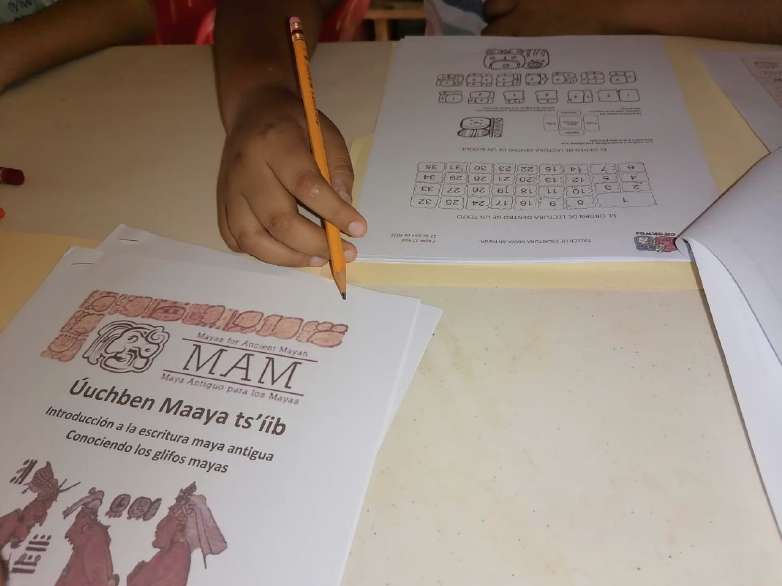
Materials that were used in the workshop
In each workshop, before entering the subject, they were asked if they knew of any place where there were traces of Úuchben ts’íib or ancient Mayan writing or at least heard about a Maya site or settlement. After identifying the knowledge that children and young attendees have of the topic, I explained in broad strokes about the sites where writing has been done (such as Palenque, Ek Balam, Uxmal, Chichen Itzá, to name a few).
Then it was explained to them that there are people dedicated to painting and writing and that they were named AJ TSÍIB and that one day they could become one if they set their minds to it. The importance of reading, studying and writing was explained to them, as well as listening and understanding what the grandparents tell us in the form of stories. As they reviewed the syllabary, it was explained to them that the basis of ancient Mayan writing is made up of many signs and symbols known as hieroglyphs or simply glyphs.

Students with the syllabary are identifying syllables within a block
While working with the syllabary, the children discovered that despite the fact that there are many signs, some of them are variations of the same sign, and different signs may have the same meaning. Several examples were given.
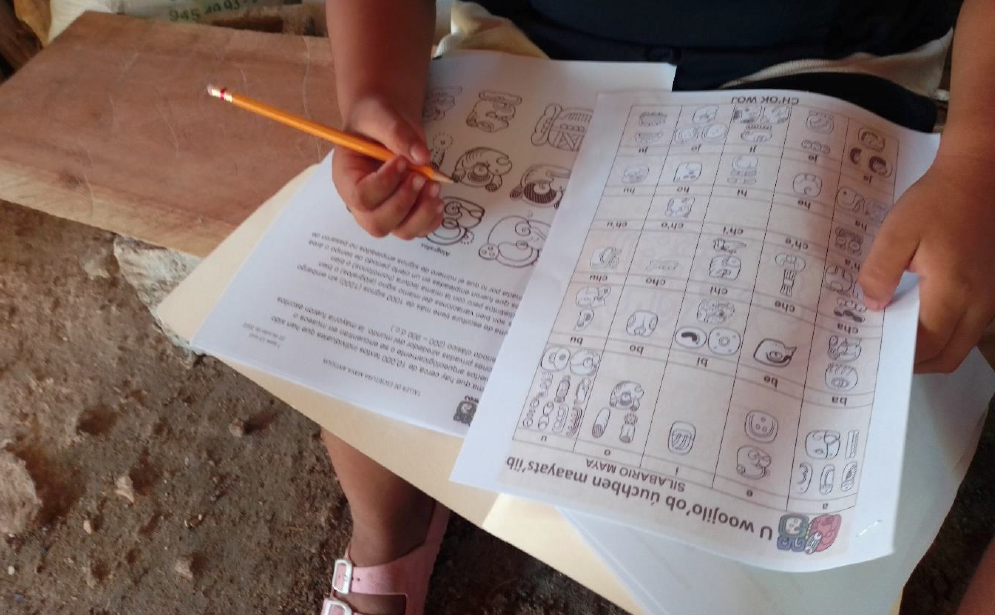
Identifying the variations of the same sign (allographs)
Briefly, the students were also taught that there are signs that represent complete words, or “logograms.” In the material provided along with their syllables, some examples were shown, and working individually or in teams, the children identified the same syllables. Once one of these was recognized, the children said which syllable they corresponded to out loud.
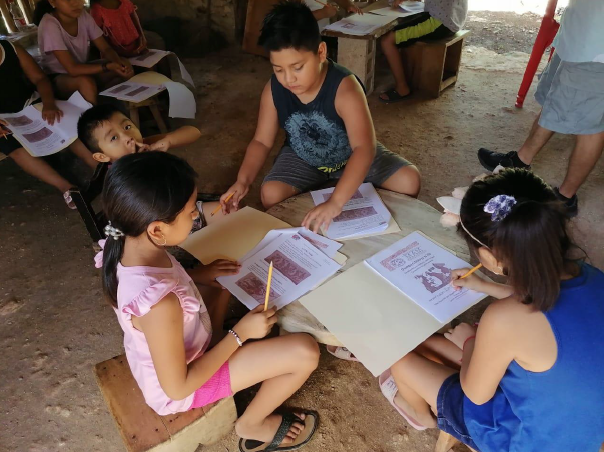
Children of Chichimilá in the Úuchben Ts’íib workshop
After the previous activity and having known the shapes and symbols of the syllables, the reading order within a text and a block was explained, for which the children relied on their work material.
With the exercises of the didactic material, each student was dedicated to developing the exercises with the advice of the instructor. Sometimes, the same students were in charge of advising their classmates. This process strengthened the knowledge obtained in a better way.
Once the children performed the exercises, they continued to verify whether they were indeed correct. That was the moment where they reaffirmed that each block had a meaning, and within the exercises they understood that they meant words. After recognizing the reading order of the blocks, each of the words contained in the block was explained to the children while they reaffirmed their learning.
In Sinanché, the evolution of Maya writing was explained where, previously, Fray Diego de Landa considered them an alphabet, but later Yuri Knorozov, based on extensive knowledge and with examples, deciphered that the writing was actually syllabic.
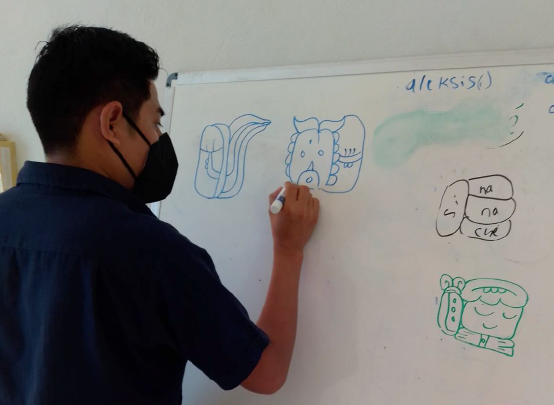
Gregorio demonstrates glyph blocks of the Úuchben Ts’íib
As a final test, they carried out an exercise that consisted of identifying a phrase written in blocks of glyphs, something interesting, since everything seen during the workshop was put to the test.

Students decipher a phrase in Maya glyphs
Knowing the syllabary and the reading and writing order of the blocks of glyphs, they prepared to make their final project, which consisted of writing in glyphs the name of a plant or tree endemic to the region.

Results of the workshop, from left to right:
Abal–plum; Iik–chile; Pichi’–guava; and K’óopte’–ziricote
An important result of this workshop in both places is the interest of children and young people in continuing to acquire this knowledge and participate in activities related to ancient Maya writing.

José Alfredo Hau accompanying the children in the workshop in Chichimilá

Coloring syllables
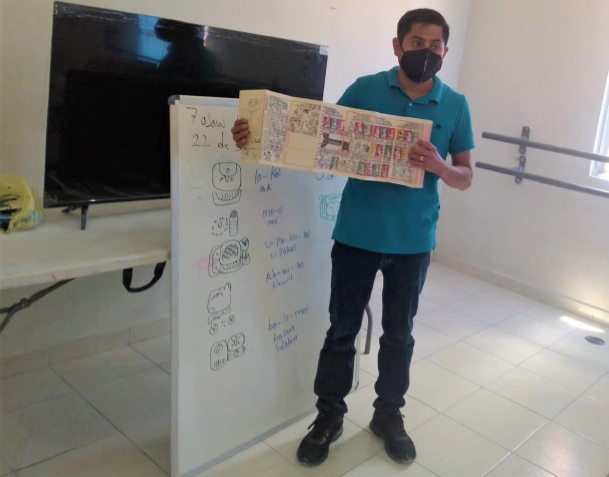 Gregorio demonstrating a copy of the Dresden Codex to the students in Sinanché
Gregorio demonstrating a copy of the Dresden Codex to the students in Sinanché

Students from the workshop in Sinanché


